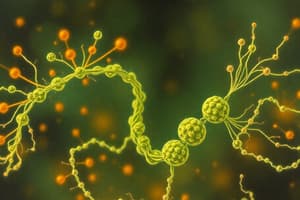Podcast
Questions and Answers
Which of the following best describes the relationship between the speed of ATP production and the efficiency of ATP production in different energy systems?
Which of the following best describes the relationship between the speed of ATP production and the efficiency of ATP production in different energy systems?
- The energy systems that are the slowest at producing ATP are moderately efficient at producing ATP, providing a steady supply over longer durations.
- The phosphagen system is both the fastest and most efficient energy system for ATP production.
- The energy systems that produce ATP the fastest are also the most efficient at producing ATP.
- There is generally an inverse relationship: faster ATP production tends to result in lower efficiency, and vice versa. (correct)
During a 400m race, an athlete primarily relies on which energy system(s) to produce ATP?
During a 400m race, an athlete primarily relies on which energy system(s) to produce ATP?
- An equal combination of the phosphagen and oxidative systems.
- Predominantly the phosphagen system, with minor contributions from glycolysis.
- Primarily glycolysis, with contributions from the phosphagen and oxidative systems. (correct)
- Almost exclusively the oxidative system due to the endurance nature of the race.
Where does glycolysis take place within muscle cells (myocytes)?
Where does glycolysis take place within muscle cells (myocytes)?
- Sarcoplasm (correct)
- Endoplasmic Reticulum
- Mitochondria
- Nucleus
During a high-intensity exercise lasting approximately 12 seconds, such as a powerlifting set, which energy system is the primary contributor to ATP production?
During a high-intensity exercise lasting approximately 12 seconds, such as a powerlifting set, which energy system is the primary contributor to ATP production?
What is the role of the enzyme ATPase?
What is the role of the enzyme ATPase?
During a long-distance run, which metabolic process is most likely upregulated to provide energy?
During a long-distance run, which metabolic process is most likely upregulated to provide energy?
An athlete transitions from a resting state to sprinting. What is the approximate increase in energy expenditure (EE) that occurs?
An athlete transitions from a resting state to sprinting. What is the approximate increase in energy expenditure (EE) that occurs?
Which energy system predominates during short, high-intensity bursts of activity, such as a 100-meter sprint?
Which energy system predominates during short, high-intensity bursts of activity, such as a 100-meter sprint?
In which cellular compartment does the oxidative energy system primarily function?
In which cellular compartment does the oxidative energy system primarily function?
What characteristic primarily determines which energy system is most active at a given time?
What characteristic primarily determines which energy system is most active at a given time?
If a marathon runner generates 80 kg of ATP during a 2.5-hour race, approximately what percentage of their body mass do they resynthesize in ATP each day, assuming they weigh 70kg?
If a marathon runner generates 80 kg of ATP during a 2.5-hour race, approximately what percentage of their body mass do they resynthesize in ATP each day, assuming they weigh 70kg?
Which process describes the breakdown of triglycerides into glycerol and fatty acids?
Which process describes the breakdown of triglycerides into glycerol and fatty acids?
What is the primary function of beta oxidation?
What is the primary function of beta oxidation?
During exercise, if one ATP molecule is used per actin-myosin powerstroke, approximately how many ATP molecules are required for a single muscle twitch in the biceps brachii, given the parameters of 300 myosin heads per sarcomere, 100,000 sarcomeres per fiber, and 250,000 fibers?
During exercise, if one ATP molecule is used per actin-myosin powerstroke, approximately how many ATP molecules are required for a single muscle twitch in the biceps brachii, given the parameters of 300 myosin heads per sarcomere, 100,000 sarcomeres per fiber, and 250,000 fibers?
Which statement correctly describes the role of ATP in cellular energy processes?
Which statement correctly describes the role of ATP in cellular energy processes?
What is the primary role of energy stores other than ATP within a cell?
What is the primary role of energy stores other than ATP within a cell?
Which of the following statements accurately describes the two major energy-transforming activities of cells?
Which of the following statements accurately describes the two major energy-transforming activities of cells?
Which of the following best describes the process of glycolysis?
Which of the following best describes the process of glycolysis?
In which process is glucose synthesized from non-carbohydrate precursors such as amino acids or lactate?
In which process is glucose synthesized from non-carbohydrate precursors such as amino acids or lactate?
What metabolic process describes the breakdown of glycogen into glucose molecules?
What metabolic process describes the breakdown of glycogen into glucose molecules?
If the body needs to store glucose for later use, which process would be utilized?
If the body needs to store glucose for later use, which process would be utilized?
Flashcards
Bioenergetics
Bioenergetics
The study of how energy is transformed in living organisms.
Adenosine Triphosphate (ATP)
Adenosine Triphosphate (ATP)
A high-energy molecule that stores and transfers energy for all cellular processes.
Glycolysis
Glycolysis
The breaking down of a glucose molecule.
Gluconeogenesis
Gluconeogenesis
Signup and view all the flashcards
Glycogenolysis
Glycogenolysis
Signup and view all the flashcards
Glycogenesis
Glycogenesis
Signup and view all the flashcards
Cell's 1st Energy Task
Cell's 1st Energy Task
Signup and view all the flashcards
Cell's 2nd Energy Task
Cell's 2nd Energy Task
Signup and view all the flashcards
Lipogenesis
Lipogenesis
Signup and view all the flashcards
Lipolysis
Lipolysis
Signup and view all the flashcards
Beta Oxidation
Beta Oxidation
Signup and view all the flashcards
Proteolysis
Proteolysis
Signup and view all the flashcards
Energy Systems
Energy Systems
Signup and view all the flashcards
Phosphagen System
Phosphagen System
Signup and view all the flashcards
Glycolytic System
Glycolytic System
Signup and view all the flashcards
Oxidative System
Oxidative System
Signup and view all the flashcards
Catabolic Processes
Catabolic Processes
Signup and view all the flashcards
Anabolic Processes
Anabolic Processes
Signup and view all the flashcards
ATPase Reaction
ATPase Reaction
Signup and view all the flashcards
Energy Systems Ranking
Energy Systems Ranking
Signup and view all the flashcards
Glycolysis Location
Glycolysis Location
Signup and view all the flashcards
Study Notes
- Bioenergetics Introduction
ATP Usage During Exercise
- One ATP molecule breaks down for each actin-myosin powerstroke.
- There are 300 myosin heads per sarcomere.
- There are 100,000 sarcomeres per fiber.
- There are 250,000 fibers in the biceps brachii.
- A single muscle twitch requires approximately 7.5 billion ATP molecules.
Adenosine Triphosphate (ATP)
- Potential energy within ATP molecules powers all of the cells' energy-requiring processes.
- All other energy stores are used to replenish ATP by phosphorylation of ADP.
- Cells' two major energy-transforming activities:
- Extract potential energy from food and conserve it within the bonds of ATP
- Extract and transfer the chemical energy in ATP to power biologic work.
Bioenergetics Overview
- Bioenergetics pathway includes: Glucose -> Glycolysis -> Pyruvate -> Acetyl CoA -> Krebs cycle
- Bioenergetics pathway includes: Lipids - > B-oxidation - > Acetyl CoA - > Krebs Cycle
Bioenergetics Key Terms
- Glycolysis refers to the catabolism of a glucose molecule.
- Gluconeogenesis refers to the building of a glucose molecule from amino acids or lactate.
- Glycogenolysis refers to the catabolism of glycogen into glucose molecules.
- Glycogenesis refers to the combining of glucose molecules to store as glycogen.
- Lipogenesis refers to the combining 3 fatty acids with a glycerol molecule to form a triglyceride.
- Lipolysis refers to breaking a triglyceride into 1 glycerol and 3 fatty acids.
- Beta oxidation refers to catabolizing fatty acids into acetyl-CoA molecules.
- Proteolysis refers to catabolizing protein to amino acids.
Energy Expenditure
- There is a 4x increase in energy expenditure when going from sitting to walking.
- There is a 120x increase in energy expenditure when going from walking to sprinting.
- Average person resynthesizes 75% of their body mass in ATP each day.
- A person running a 2.5 hour marathon can generate 80 kg (176 lb) of ATP during the run alone.
Biological Energy Systems
- Three basic energy systems exist in muscle cells to replenish ATP including:
- Phosphagen (sarcoplasm)
- Glycolytic (sarcoplasm)
- Oxidative (mitochondria)
Fuel Substrates Rate vs. Capacity
- Phosphagen info:
- Location: Sarcoplasm
- Oxygen necessary: No
- Relative rate of ATP per second: 10
- ATP per molecule of substrate: 1
- Available capacity: less than 15 seconds
- Glycolytic info:
- Location: Sarcoplasm
- Oxygen necessary: No
- Relative rate of ATP per second: 5
- ATP per molecule of substrate: 2-3
- Available capacity: 1-2 minutes
- Oxidative (from Carbs) info:
- Location: Mitochondria
- Oxygen necessary: Yes
- Relative rate of ATP per second: 2.5
- ATP per molecule of substrate: 32-33
- Available capacity: 90 minutes
- Oxidative (from fat) info:
- Location: Mitochondria
- Oxygen necessary: Yes
- Relative rate of ATP per second: 1.5
- ATP per molecule of substrate: greater than 100
- Available capacity: Days
- Gross production is 36-39 ATP per molecule of carbohydrate, but the net production is 32 ATP per glucose, as this excludes the energy cost of transporting through membranes.
Biological Energy Systems (cont.)
- Exercise intensity determines the primary energy system utilized
- Higher intensity demands faster ATP production.
- Lower intensity allows for slower, more efficient ATP production.
- At no time during exercise or rest does any single energy system completely supply energy.
- Events lasting 0-6 seconds and at extremely high intensity utilize the Phosphagen system.
- Events lasting 6-30 seconds and at very high intensity utilize the Phosphagen and fast glycolysis systems.
- Events lasting 30 seconds to 2 minutes and at high intensity utilize the Fast glycolysis system.
- Events lasting 2-3 minutes and at moderate intensity utilize the Fast glycolysis and oxidative system.
- Events lasting longer than 3 minutes and at low intensity utilize the Oxidative system.
- Table 2.3 assumes that an individual is maintaining intensity and pacing for the best possible time for a given event.
- Sprinting the first lap of a mile and then walking the next three laps is not conducive to this table.
- The phosphagen system can last up to 15 seconds but not only 6 seconds.
Review Questions
- Know catabolic and anabolic terms involved in bioenergetics.
- Identify where the processes take place (cell type and location in the cell).
- Glycolysis takes place in the sarcoplasm of myocytes.
- Identify ATP's chemical structure and distinguish it from ADP and AMP.
- Know the ATPase reaction.
- Know how the different energy systems rank regarding speed and efficiency of ATP production.
- Efficiency refers to the # of ATP produced per substrate used.
- Apply the bioenergetics information to varied intensity exercises/sporting events.
- Identify predominant energy system(s) for a 40 yd dash and 400m race.
Studying That Suits You
Use AI to generate personalized quizzes and flashcards to suit your learning preferences.
Related Documents
Description
An overview of bioenergetics, focusing on ATP's role in powering cellular processes and muscle contractions. It covers how ATP is utilized during exercise and replenished through the bioenergetic pathways such as glycolysis and the Krebs cycle. Key terms and processes are explained.




